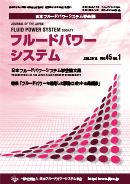All issues

Volume 45, Issue 1
Displaying 1-2 of 2 articles from this issue
- |<
- <
- 1
- >
- >|
Paper
-
Jinshi LU, Canghai LIU, Michihito SAITO, Kazuhito OSAKA, Kouichi OBA, ...2014 Volume 45 Issue 1 Pages 1-7
Published: 2014
Released on J-STAGE: June 22, 2015
JOURNAL FREE ACCESSIn this study, an Active Charge Accumulator (ACA) is proposed as a new accumulator whose output pressure can be adjusted to N levels quickly. Because an ACA is a piston type accumulator which is divided into several oil chambers, the effective area of the oil chambers in the ACA can be changed by switching the valves at the oil chamber inlets. Therefore, the required one of N-levels output pressure can be obtained. In a system with N accumulators to provide N levels output pressure, an ACA can be used to replace the N accumulators. Experimental results verified that the efficiency of the valve-controlled hydraulic servo system using a 2-level pressure ACA is greatly improved, and the power consumption of the system is reduced when compared with a traditional valve-controlled hydraulic servo system.View full abstractDownload PDF (1590K) -
Tomonori KATO, Genki HIGASHIJIMA, Takanori YAZAWA, Tatsuki OTUBO, Yusu ...2014 Volume 45 Issue 1 Pages 8-14
Published: 2014
Released on J-STAGE: June 22, 2015
JOURNAL FREE ACCESSThe aim of this research is to establish a quick and robust rotation control method for the air turbine spindle used in ultra-precision machining. In ultra-precision machine tool, such as an aspherical lens generator, air turbine spindles with aerostatic bearing are widely used due to their beneficial properties, such as high precision, high speed, low friction, and low vibration. Nevertheless, when a disturbance force (e.g., cutting force) is given to the spindle, the rotation speed of the spindle tends to decrease. Because methods of controlling the air supply pressure and the flow rate are not sufficiently precise and quick, it has been impossible to control the rotation speed and the output torque of the air turbine spindle. To solve these problems, in this research, we developed a high-precision quick-response pneumatic pressure regulator and applied it to the rotation feedback control of an air turbine spindle. We also set a disturbance force observer in the feedback control system, in order to avoid rotation speed change caused by the disturbance force given to the air turbine spindle. By simulation and experiment, the effectiveness of the proposed method is evaluated.View full abstractDownload PDF (2902K)
- |<
- <
- 1
- >
- >|